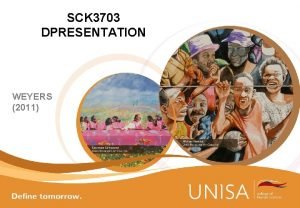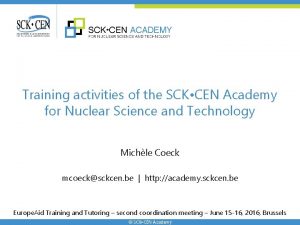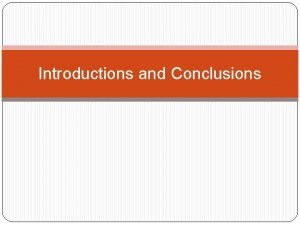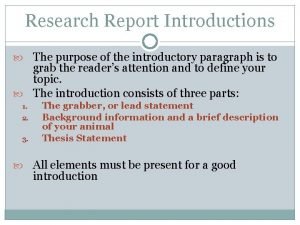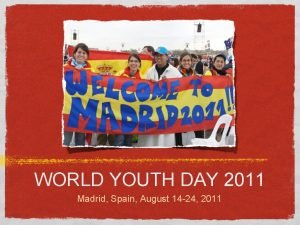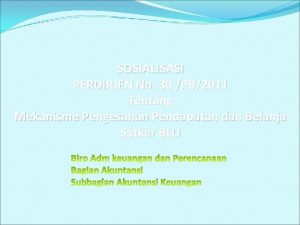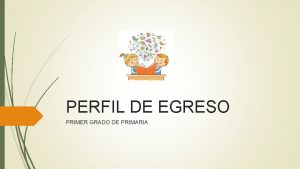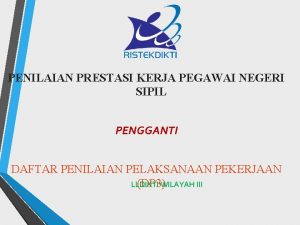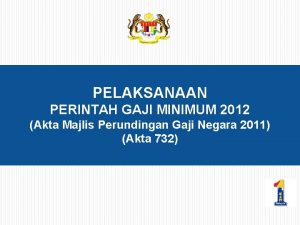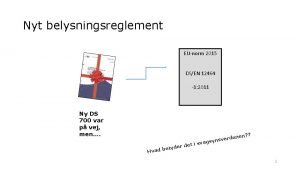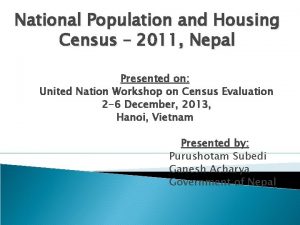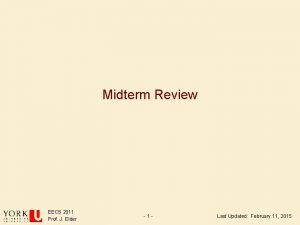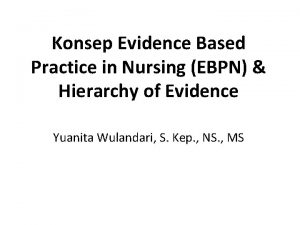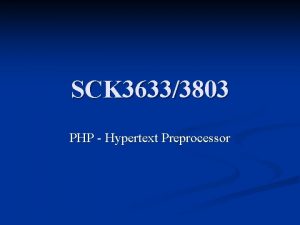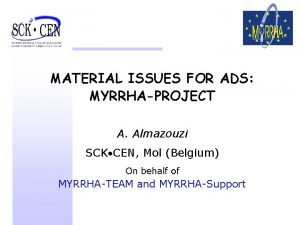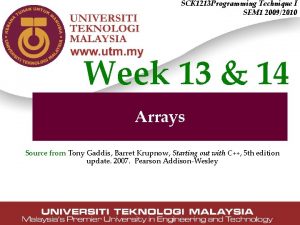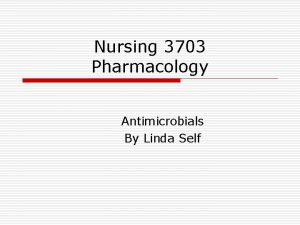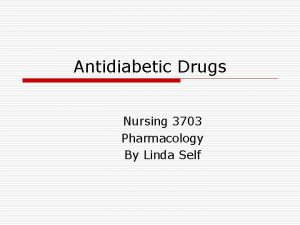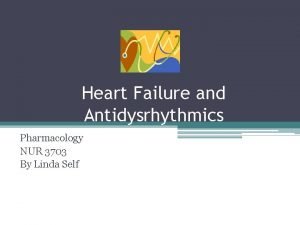SCK 3703 DPRESENTATION WEYERS 2011 INTRODUCTION Purpose of



































- Slides: 35

SCK 3703 DPRESENTATION WEYERS (2011)

INTRODUCTION Purpose of the presentation is to teach you • Concept community work and community development (Weyers. 2011) • Other concepts: Impediment, Need, Strength and practice model (Weyers. 2011) • Perspectives of Community Work (Weyers. 2011) • Community Work process (Weyers. 2011) • Community Work models (Weyers. 2011) • Principles of Community Work (Study guide & Schenck et al) • Practitioner knowledge requirements (Weyers. 2011)

CONCEPTS COMMUNITY DEVELOPMENT(Weyers. 2011) • CD is the method, process, programme and strategy by means of which change agents: ü speed up the rate at which a community develops; ü provide direction to the development process to realise objectives within the economic, psychosocial, bio physiological, technological, spiritual cultural, political, environmental, educational and other spheres of life; ü makes the goal attainment process as cost effective, streamlined and sustainable as possible so that both human and environmental resources are used optimally; and ü contribute to human growth and the unlocking of human potential by empowering community members to take responsibility for their own, as well as the whole system's development.

CONCEPTS COMMUNITY WORK (Weyers. 2011) • CW is the method of social work ü that consists of the various processes and helping acts of the social worker ü that are targeted at the community system, as well as its sub systems and certain external systems, ü with the purpose of bringing about required social change ü with the help of especially community development, social planning, community education, social marketing and social action as practice models.

CONCEPTS • The vision of community work • • • Community work's vision and mission is the same as that of social work. Social work vision is the "good society", or "just society". Such a society would, inter alia, provide for everyone: warm and safe housing, an adequate supply of water and nutritious food, challenging jobs, loving and caring friends and family, access to the services and resources they need, the will and skills to deal effectively with life's daily challenges, minimal stress, crime and suffering, the opportunity to participate in the plans and policies that effect their lives, the opportunity to live satisfying and fulfilling lives, and a balance between individual and collective rights and responsibilities. 1

PURPOSE OF COMMUNITY WORK • • • The purpose of community work The specific contribution community work make to achieving the profession's envisaged end result (i. e. a ‘good/just society’) entails social change on three levels. They are: To enhance people's problem solving, coping and developmental capacities To create and maintain the opportunities, resources and services that people need and To link people with the systems that provides them with the required resources, services and opportunities (Weyers. 2011: 31) The goals of community work A distinction is often drawn between three types of community work goals. They are the so called task goals, process goals and operational goals. Task goals essentially denote some type of intended change in the circumstances or environment of a community. They cover, amongst others, the creation of circumstances in which community systems are empowered to perform their problem solving, needs fulfilment, resource/service utilisation and environmental modification tasks in a more effective way.

GOALS OF COMMUNITY WORK • • The goals of community work A distinction is often drawn between three types of community work goals. They are the so called task goals, process goals and operational goals. Task goals essentially denote some type of intended change in the circumstances or environment of a community. They cover, amongst others, the creation of circumstances in which community systems are empowered to perform their problem solving, needs fulfilment, resource/service utilisation and environmental modification tasks in a more effective way. Process goals essentially denote a 'people-changing' type of outcome. They especially cover the bringing about of some or other form of change in people's knowledge, attitudes and behaviour (KAB Operational goals The operational goals denote the type of change that a practitioner needs to bring about in his employer organisation in order to make it a more effective service delivery system.

COMMUNITY • A community is a social system which originates when a population of individuals localised in a specific geographic area, establishes and utilises structures and relationships to deal with impediments and at the same time develops a sense of communal thinking, identity and activities. The dimensions of a community are social, spatial, functional and cultural symbolic dimensions. The demarcations of community are contextual, geo spatial and geo functional • The social dimension of a community Community is a form of social entity. It consist of both individuals and the social relationships formed with each other and their environment. • The spatial dimension of a community It is a neighbourhood, village, town, city, region, nation or even the planet as such a geographic entity. The functional dimension of a community • It covers the purpose of such a system. • The cultural-symbolic dimension of a community • It refers to the 'entity' with which people identify or have a shared emotional connection. These could include: a school, university or employer, a similar service provider (e. g. the local municipality or hospital), an ethnic or language group; a religion and its institutions; a sub culture or gang; or even the same problems or disabilities (e. g. blindness). 8

COMMUNITY • • • THE PRACTICAL DEMARCATION OF COMMUNITIES The 'contextual' community It refers to the setting in which you operate. It includes both the employer organisation and the geographical community or communities in which it operates. It typically results in the compiling of an organisation and a community profile report. Geo-spatial communities Geo physical boundaries include amongst others rivers and fences (e. g. in the case of farms) and streets (e. g. in the case of neighbourhoods and suburbs). Geo-social communities The social criteria usually comprise one or more of the demographic characteristic that people have in common. These include: age, language , status, culture , marital state, social problem and affiliation. 1 Geo-functional communities It consist of one or more of the functions that communities should fulfil. These include the provision of goods and services, employment, political organisation and participation.

PRACTICE MODELS Weyers (2011) refers to five community work models 1. Community development 2. Social planning 3. Community education 4. Social marketing and 5. Social action Practice model: is a set of concepts and principles that guide intervention.

PRACTICE MODELS Community development Model (Weyers. 2011) • Community development is a broad approach to working with groups and individuals to help them acquire skills and confidence to improve the quality of the lives of its members and communities. • It is based on the perception that the community members are in the best position to develop themselves and their own communities and to eliminate the challenges that obstruct this process. • The practitioner must work on grassroots level. Development should be community driven and owned process. • The practitioners must involve as many members of geo functional community as practically possible in small task –oriented self help groups. • They would use these groups as instruments to bring about the necessary changes within the community, as well as in the community‘s relationships with external resources and institutions. • The practitioner ultimate goal is to empower the community with appropriate attitudes and behaviour patterns

PRACTICE MODELS Community Education Model (Weyers. 2011) • It is based on the perception that the effectiveness of a community‘s social functioning will be determined by its member’s individual and collective knowledge, attitude, behaviour and skills. • The basic goal of community education (public education) is to eliminate ignorance by empowering individuals, groups and communities with knowledge, attitude and skills (KAS) that they require to take control of their lives and to contribute effectively to the environment in which they live. • Within community education a distinction can be drawn between eight broad fields of domains of human functioning that can be targeted by KAS focused empowerment. They are intellectual, emotional, physical, social/civic, occupational, environmental, financial/material and spiritual/cultural domains

PRACTICE MODELS Social Planning Model (Weyers. 2011) • The basic perception of communities is that they require the services of experts to help them prevent, treat or resolve social problems and to create the opportunities and the mechanisms that would enable them to satisfy their needs. • This invariably makes social planning a somewhat top down approach. • It is based on the perception that any community member can be affected by a social problem. The practitioner would have to step in and bring about a progressively more effective adjustment between social welfare resources and needs. • This is done in three basic ways: by establishing new services where these are lacking, by improving the quality of existing services or by facilitating the community’s access to services. The new or improved service can target any type of social pathology

PRACTICE MODELS Social Marketing Model (Weyers. 2011) • It focuses on changing social attitudes and associated behaviour • It is based on the central idea that the effectiveness of a society’s social functioning is determined by its members’ social attitude and associated behaviour. The extent to which they support or utilise social services • Social marketing tries to change people’s behaviour to primarily for the benefit of the individuals involved and society as a

PRACTICE MODELS Social Action Model (Weyers. 2011) • Social action is described as the deliberate effort to bring about socio political change in a community or societal system for the common good. • All social action approaches are based on the central idea that social problems are often the results of the abuses that stem from the inequitable distribution of power and authority within a social system, be it an organisation, a community, a country or globally. • The basic aim of social action is to address the socio political barriers, inequities and injustices that exist in a community or society so that it would contribute more fully to the common good of all citizens. • Therefore from the point of view of social work, practitioners should play a more direct role in confronting injustice and advocating the interests of the oppressed and vulnerable groups

COMMUNITY WORK PROCESS (WEYERS. 2011) Community work process has five general scientific steps: 1. 2. 3. 4. 5. Situational analysis, Identification and analysis of impediments, Formulation of a plan of action, Implementation of a plan of action and Evaluation of the process and results coupled with sustainment of change. • Each step could be divided into various tasks and procedures. • These steps and their accompanying tasks form the framework for the exploration of the way in which community work method can be applied in practice.

SITUATIONAL ANALYSIS (WEYERS. 2011) • Situational analysis basic purpose is to gain understanding of the nature of the practice situation in which the practitioner finds themselves. • This first step prepares one for the selection of the practice model or models that would be used as a basis for intervention. • The three basic tasks that must be completed are to: ü analyse the context in which services will be rendered, ü ascertain the expectations that the main role players will have the practitioner and of change and ü compare the results of the first two steps with the characteristics of the available practice models

IDENTIFICATION AND ANALYSIS OF IMPEDIMENTS (WEYERS. 2011) • The basic purpose of this step is to identify and gain an understanding of the nature of social problems, social needs and/or the unutilized potential in the community that should be the focus. • This should be combined with preliminary feasibility study. • The three core tasks to be performed are to ü identify the impediments that should receive attention. ü define, analyse and prioritise the impediments. ü do a preliminary feasibility study

FORMULATE A PLAN OF ACTION (WEYERS. 2011) • The nature and format of the plan of action will to a large extent be determined by the selected practice model(s). • There are three generic tasks that should be performed in the development of mezzo level community work programmes. • The tasks are to: ü Verify and operationalize the practice model. ü Select the operational elements of action. ü Formulate programmes and projects

IMPLEMENTATION OF A PLAN OF ACTION (WEYERS. 2011) • In this step, the practice models are operationalized, material and human resources are mobilised, change is brought about, goals and objectives are attained and impediments are eliminated. • The procedure to be followed when implementing the plan of action is to a large extent determined by the chosen practice model and its unique characteristics of each practice setting. • There are three tasks that are common to most of the models. ü the legitimization of the plan, ü implementation of the plan and ü the execution of change inducing acts

EVALUATE THE PROCESS AND RESULTS AND SUSTAIN CHANGE (WEYERS. 2011) • There are three main tasks that should be completed as part of the last step which are ü evaluation of the process itself, ü evaluation of the results that have been achieved and ü the sustainment of these results. • It is also important to note that evaluation ongoing responsibility

PRACTICE PERSPECTIVES (WEYERS. 2011)

PRACTICE PERSPECTIVES (WEYERS. 2011) THE ECOSYSTEMS PERSPECTIVE Basic implication: þ Man and his environment are interrelated þ Change one subsystem and you influence the rest

PRACTICE PERSPECTIVES (WEYERS. 2011) THE STRENGTHS PERSPECTIVE: þ þ It is mindset that the practitioner should adopt Everything that s/he does should be based on the principal of helping the client system discover, embellish, explore and exploit their strengths and resources

PRACTICE PERSPECTIVES (WEYERS. 2011) • Ecosystem perspective it should, among others, be clear that man and his environment are interdependent and that a change in one subsystem will lead to a change in others. • One effect of this is that the actions of an individual or small group of people can have an impact on the entire system, and vice versa. • Strengths perspective it should, among others, be clear that man and his environment should not (only) be seen as a “reservoir of problems, needs and deficits”, but rather as one of strengths and resources/ assets. • Community work should focus on the ways and means by which these strengths/ assets could be utilised to bring about beneficial change.

ASSET BASED COMMUNITY DEVELOPMENT APPROACH • The Assets Based Community Development Approach was developed by Kretzmann and Mc. Night. • The ABCD emphasises the strength and assets approach in working with communities. It encourages appreciation and mobilization of the positive assets and strengths in communities. • ABCD is optimistic, it is internally focused, it starts with what is present in the community and builds on existing capacity and assets in the community. It is relationship driven and depends on collaboration between individuals across different sectors. • It acknowledges and embraces community rooted traditions and aims to promote sustainable growth in a community.

ASSET BASED COMMUNITY DEVELOPMENT APPROACH • Assets include objects or things, qualities, conditions or entities, resources or sources of strength. • Assets may be person, physical structures, natural resources, institutions, business or informal organisations. • Assets also include recognised rights, capacities, capabilities and access to resources (physical, economic, political, social and cultural) in a community. • ABCD focuses primarily on social assets such as individual assets (gifts, skills, talents and capacities of all citizens). The quality of relationships among individuals, families, groups and associations (churches, clubs, ) and networks. • ABCD approach, consider the strengths/ assets as a frame or chosen perspective or construction through which to initially see the community. • The ABCD approach building block is the recognition of social capacity of the community. It is a people centred participatory approach to development based on the principles of empowerment and ownership. ABCD approach assumes that community development uses internal

ASSET BASED COMMUNITY DEVELOPMENT APPROACH • The ABCD approach building block is the recognition of social capacity of the community. It is a people centred participatory approach to development based on the principles of empowerment and ownership. ABCD approach assumes that community development uses internal strengths and assets and encourages positive action for change. • The basic premise of Asset Based Community Development Model perception of the community is that all communities, no matter how poor possess strengths, assets and energies that can contribute tremendously to self sustained improved quality of life. • ABCD approach focus not on what people lack, but rather on how they cope and survive, in spite of constraints, lacks and shocks. • The ABCD approach assumes that as people become aware of their strengths and resources, the likelihood of reaching their goals and realising their potential increases.

COMMUNITY WORK PRINCIPLES Human orientation • Human orientation is operationalised by listening to the people in need in their social, economic and political context and responding with acceptance to the people’s needs. • The values of community development workers must be respect for people, their values, experiences, skills and potential. • People are experts in their own lives and experiences. • One of the advantages of human orientation is that people’s capabilities are recognised and increased.

COMMUNITY WORK PRINCIPLES Participation • Participation as a principle emerges from the principle of human orientation. • Participation refers to people being involved as equal partners. • Participation entails more than merely involving or including people. Participation is the active involvement of ordinary people in the determination, implementation and evaluation of social development programmes targeted at benefiting them. • In working with a community, involvement means allowing the community to take part in what an outsider may be thinking and planning and may want to accomplish in that community. • Real participation implies that people are not passive spectators of something such as their development, but share fully and have an equal voice in every effort directed towards change. They also decide what should change and how it should change. • One of the advantages of participation is that it contributes to ownership and sustainability of the development process and project

COMMUNITY WORK PRINCIPLES Empowerment • Empowerment is a process of human development or the development of the person to be able to make his own choices and develop the capacity and take responsibility for those choices. • Empowerment begins by taking people who are voiceless and without choice seriously and listening to them with empathy and understanding. • Empowerment means enabling people to demonstrate and increase their ability or capacity, and to influence and control their decisions that affect their life space for their own benefit and the benefit of others, • it also means an increase in the power to act, to change and prevent the recurrence of problems. • True participation brings empowerment.

COMMUNITY WORK PRINCIPLES Ownership • Ownership refers to knowing and experiencing that something belongs to oneself, not to someone else. • It also refers to being in control and responsibility, being accountable and being capable of responding to what is required. • Ownership is applied through people centredness, supporting the initiative of people, facilitating cooperation, facilitating collective planning, action reflection, amongst others. • Ownership is a consequence of participation and empowerment Release • To release is to set free or liberate. Liberation, development and transformation are all aspects of the same process. Development is about liberating people from all that holds them back from a full human life.

PRACTITIONER KNOWLEDGE REQUIREMENTS The practitioner should possess theoretical and practical knowledge of wide range of subjects: Some elements that should form part of the practitioner’s knowledge from level 1 to level 5 could be summarised as follows: • Level 1: Knowledge of the broad environment within which the practitioner is operating and nationwide. The economic, psychosocial, bio physical, spiritual cultural, technological/ professional, educational and political trends. The practitioner must have some understanding of how these trends impact the local community • Level 2: Knowledge of social work as a science and a profession and theories, models, typologies and processes available to the practitioner • Level 3: Knowledge of the contextual and target communities and their impediments, as well as the available resources and potential allies and opponents • Level 4: Knowledge of the nature, policies, services, resources and the strong and weak points of the employer organisation, as well as the contents and implications of the practitioner’s job description. The employer organisation is the most important tool at disposal • Level 5: Knowledge of the operational elements of action. It includes the goals, client system, impediments, programme objectives and services that could potentially become part of service delivery. The practitioner must have self knowledge especially strong and weak points (Weyers. 20111: 65).

PRACTITIONER KNOWLEDGE REQUIREMENTS The practitioner should possess theoretical and practical knowledge of wide range of subjects: Some elements that should form part of the practitioner’s knowledge from level 1 to level 5 could be summarised as follows: • Level 1: Knowledge of the broad environment within which the practitioner is operating and nationwide. The economic, psychosocial, bio physical, spiritual cultural, technological/ professional, educational and political trends. The practitioner must have some understanding of how these trends impact the local community • Level 2: Knowledge of social work as a science and a profession and theories, models, typologies and processes available to the practitioner • Level 3: Knowledge of the contextual and target communities and their impediments, as well as the available resources and potential allies and opponents Level 4: Knowledge of the nature, policies, services, resources and the strong and weak points of the employer organisation, as well as the contents and implications of the practitioner’s job description. The employer organisation is the most important tool at disposal • Level 5: Knowledge of the operational elements of action. It includes the goals, client system, impediments, programme objectives and services that could potentially become part of service delivery. The practitioner must have self knowledge especially strong and weak points

 Weyers 2011
Weyers 2011 Cenacademy
Cenacademy Purpose sentence
Purpose sentence General purpose specific purpose central idea
General purpose specific purpose central idea Purpose of conclusion
Purpose of conclusion Introduction and purpose
Introduction and purpose Introductory paragraph format
Introductory paragraph format Purpose of introduction
Purpose of introduction World youth day spain
World youth day spain Microsoft windows small business server 2011 essentials
Microsoft windows small business server 2011 essentials Windows small business server 2011 essentials
Windows small business server 2011 essentials Typical goals of communication by seitel
Typical goals of communication by seitel Uma equipe de cientistas lançará uma expedição
Uma equipe de cientistas lançará uma expedição Per-30/pb/2011
Per-30/pb/2011 Yevarejeja yahweh
Yevarejeja yahweh Dorothea puente young
Dorothea puente young Sage act 2011
Sage act 2011 Chemistry regents 2011
Chemistry regents 2011 2011-1989
2011-1989 Boardworks ltd 2011
Boardworks ltd 2011 Perfil de egreso de primer año de primaria
Perfil de egreso de primer año de primaria Pergub 140 tahun 2011
Pergub 140 tahun 2011 Perbedaan pp 46 2011 dan pp 30 2019
Perbedaan pp 46 2011 dan pp 30 2019 Usa infotehnoloog 1955-2011
Usa infotehnoloog 1955-2011 Kiraan gaji pekerja
Kiraan gaji pekerja Paradise hotel 2011 deltakere
Paradise hotel 2011 deltakere Legea 211/2011
Legea 211/2011 Ds/en 12464-1
Ds/en 12464-1 National population and housing census 2011
National population and housing census 2011 Eecs2011
Eecs2011 Unieważnienie matury 2011
Unieważnienie matury 2011 Lloyds open form
Lloyds open form Windows movie maker 2011 download
Windows movie maker 2011 download Parts of wlmm
Parts of wlmm Ebpn adalah
Ebpn adalah Hpec 2011
Hpec 2011
